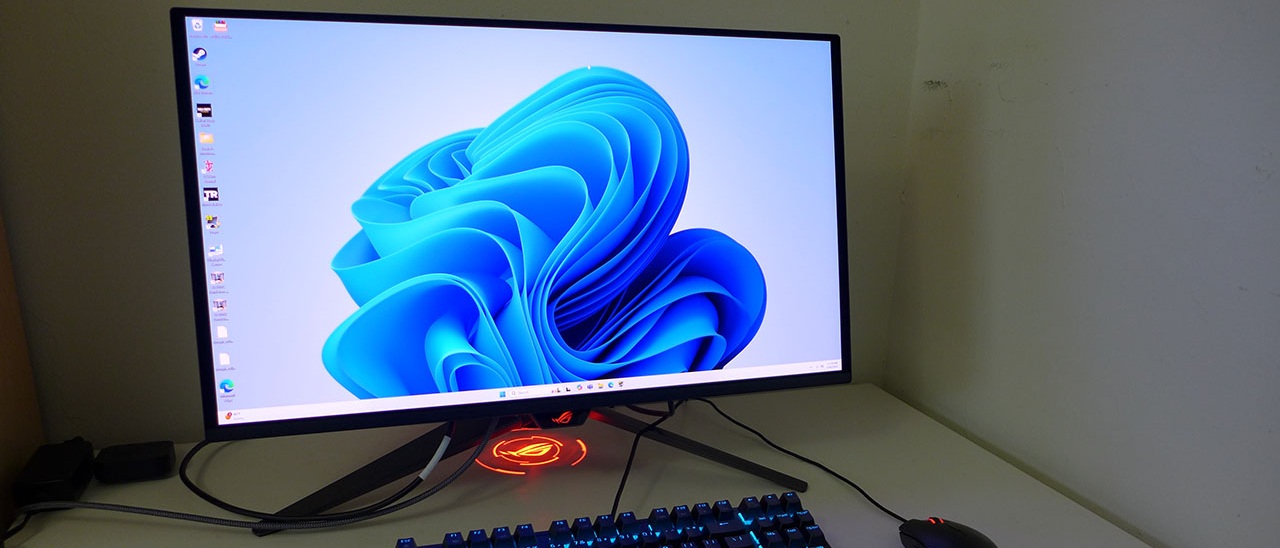Tom's Hardware Verdict
If you want the very best OLED technology has to offer, the Asus ROG Swift PG27UCDM should be on your short list. It does everything well and stands out with Dolby Vision support and incredible pixel density.
Pros
- +
Stunning image with high contrast and saturated color
- +
Accurate out of the box
- +
Flexible image and gaming options
- +
Premium video processing
- +
Dolby Vision support
- +
Premium styling and build quality
Cons
- -
No internal speakers
Why you can trust Tom's Hardware
High-end gaming PCs demand the best gaming monitors, and when you’re shopping, the first three filters you should check are “4K”, “OLED” and “240 Hz.” Most of the hits will be 32-inch panels, but if you need a smaller footprint, or are looking for maximum pixel density, there are a few 27-inch screens out there as well. Though they are a little smaller, you’re looking at 163ppi versus 138, which you can distinguish in a side-by-side comparison.
Asus looks to fill that desire with its ROG Swift PG27UCDM. This QD-OLED panel will come up in the filter set I just mentioned and deliver a full list of features, premium build quality, terrific performance, and addictive gaming. Let’s take a look.
Asus ROG Swift PG27UCDM Specs
Panel Type / Backlight | Quantum Dot Organic Light Emitting Diode (QD-OLED) |
Screen Size / Aspect Ratio | 27 inches / 16:9 |
Max Resolution and Refresh Rate | 3840x2160 @ 240 Hz |
| Row 3 - Cell 0 | FreeSync and G-Sync Compatible |
Native Color Depth and Gamut | 10-bit / DCI-P3+ |
Response Time (GTG) | 0.03ms |
Brightness (mfr) | SDR 100% field: 250 nits |
| Row 7 - Cell 0 | SDR 25% window: 450 nits |
| Row 8 - Cell 0 | HDR 3% window: 1,000 nits |
Contrast | Unmeasurable |
Speakers | None |
Video Inputs | 1x DisplayPort 2.1 |
| Row 12 - Cell 0 | 2x HDMI 2.1, 1x USB-C |
Audio | 3.5mm headphone output |
USB 3.2 | 1x up, 3x down |
Power Consumption | 48.4w, brightness @ 200 nits |
Panel Dimensions WxHxD w/base | 24 x 17.2-21.6 x 8.6 inches (610 x 437-549 x 218mm) |
Panel Thickness | 2.8 inches (71mm) |
Bezel Width | Top: 0.28 inch (7mm) |
| Row 19 - Cell 0 | Sides: 0.43 inch (11mm) |
| Row 20 - Cell 0 | Bottom: 0.55 inch (14mm) |
Weight | 16.8 pounds (7.64kg) |
Warranty | 3 years |
The PG27UCDM is every bit a flagship display, and its price of $1,200 reflects that. You can spend that same money on a 32-inch 240 Hz OLED monitor from Dough, Acer, and others. But those screens won’t give you the highest pixel density available in the mainstream, 163ppi. That’s a level of sharpness you can clearly see. The PG27UCDM makes the most of that with a Quantum Dot layer that covers over 103% of DCI-P3. Accuracy is excellent right out of the box with no need for calibration and a pro-level sRGB mode.
The panel is capable of 1,000-nit peaks in HDR mode when measuring a 3% window pattern. I got 465 nits from a 25% window, which tracks with the competition. The PG27UCDM is plenty bright, and you can see that same output in SDR mode if you turn off the Constant Brightness option. That adds another option for picture enhancement that isn’t universally available. One thing you won’t find in more than a handful of monitors is Dolby Vision. While that codec is widely supported by televisions, gaming screens rarely include it. Its dynamic tone mapping delivers a superior HDR image to HDR10’s static metadata.
Video processing starts with a 240 Hz refresh rate that can be enjoyed over any of the four video inputs. The DisplayPort is version 2.1 with 80 Gbps bandwidth, and the two HDMI 2.1 ports can move 48 Gbps. The USB-C port covers the same DisplayPort functions and adds 90 watts of power. You also get KVM with one upstream and three downstream USB 3.2 ports. And a 3.5mm headphone jack delivers audio. There are no internal speakers. ELMB is included, which operates a black frame insertion routine up to 120 Hz. And Asus has included its anti-flicker tech that maintains consistent brightness during frame rate transitions.
Peripheral features include Asus’ full array of LED lighting with Aura RGB and Light In Motion displayed by a large ROG logo in the back. The show can be synced with on-screen action if you like. Panel longevity is supported by multiple OLED care options like logo protection and pixel refresh. Extensive cooling via heatsink is also provided. Gaming aids run the full array with aiming points, sniper mode, timer, stopwatch, frame counter, and multi-display alignment marks. You can control all the fun through an extensive OSD, or with Asus’ DisplayWidget Center app
Assembly and Accessories
Asus is transitioning to fully recyclable packaging, and the PG27UCDM is from the new generation with molded pulp forms protecting the contents. The base and upright mate with a captive bolt, and the ROG log projector lens attaches with magnets. The panel snaps on to create a solid package. An included adapter provides a 100mm VESA mount if you’d rather use an arm. The accessory bundle comes in a nice zippered pouch and includes USB cables, DisplayPort, HDMI, and IEC for the internal power supply.
Get Tom's Hardware's best news and in-depth reviews, straight to your inbox.
Product 360
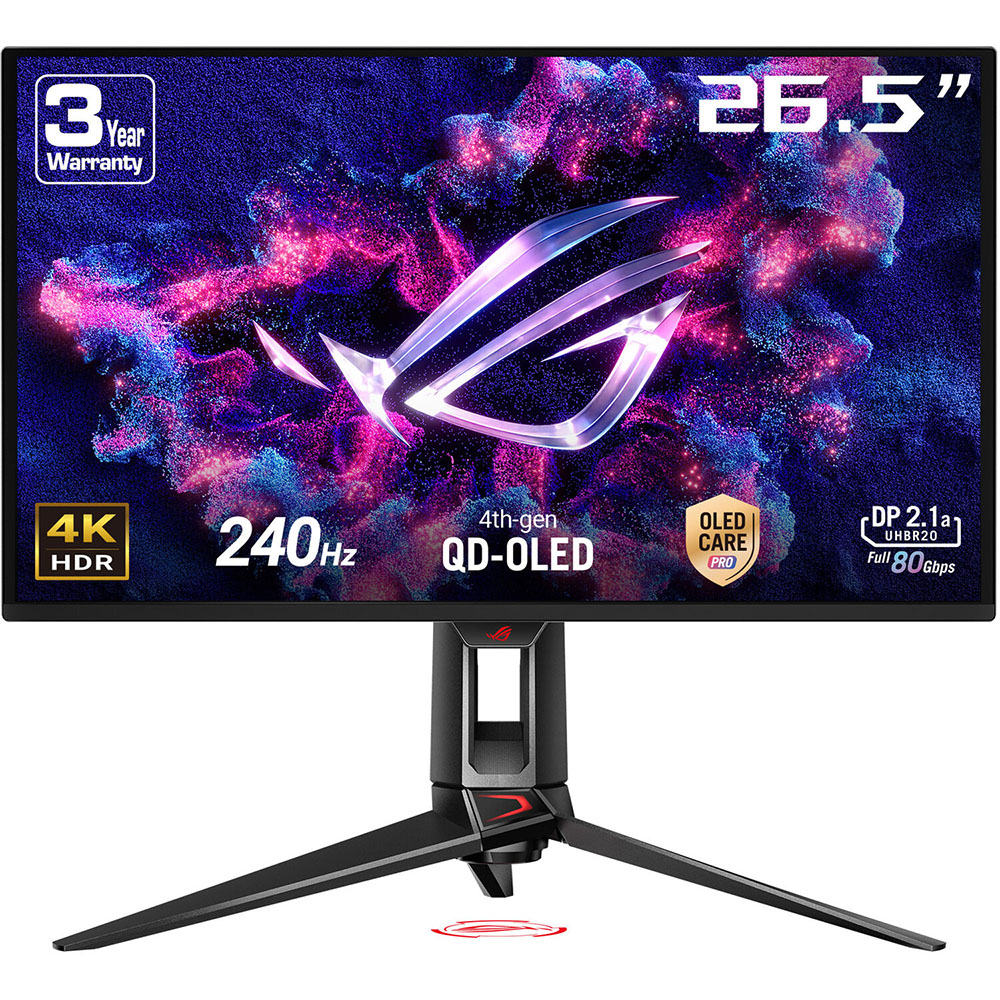
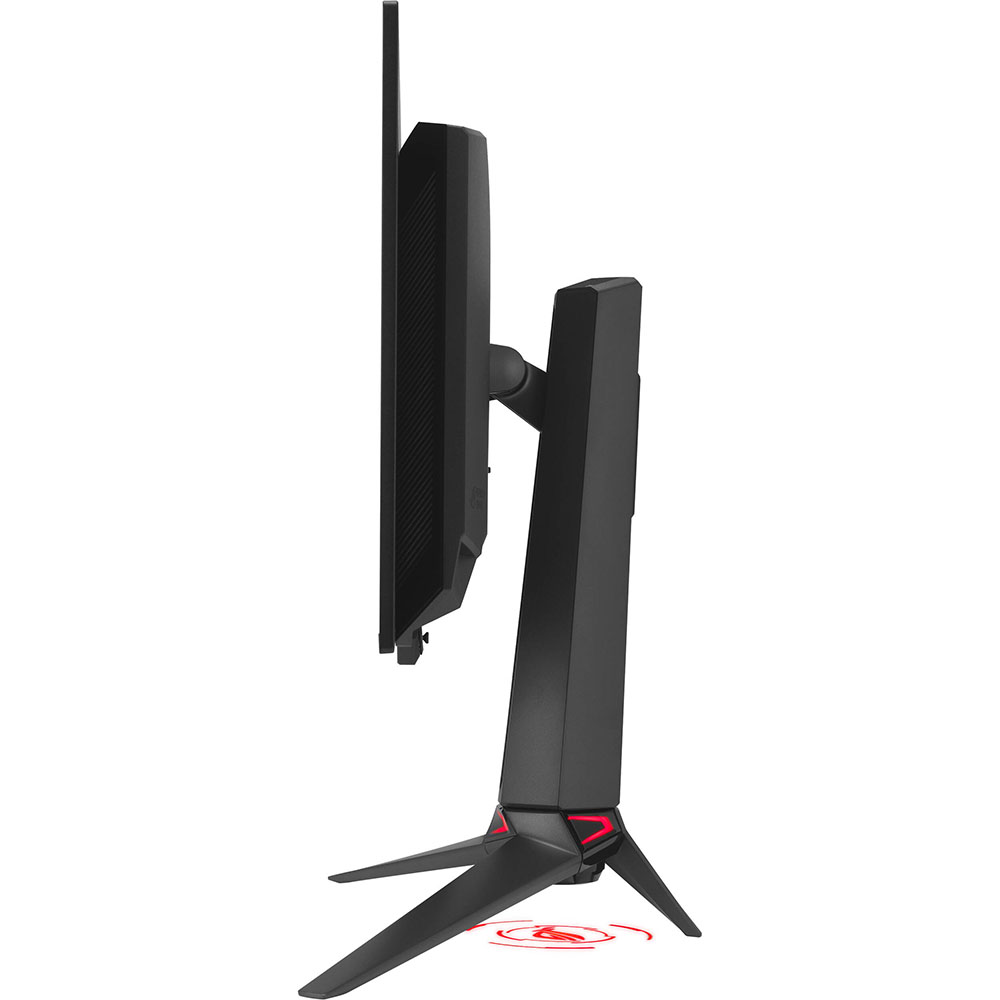
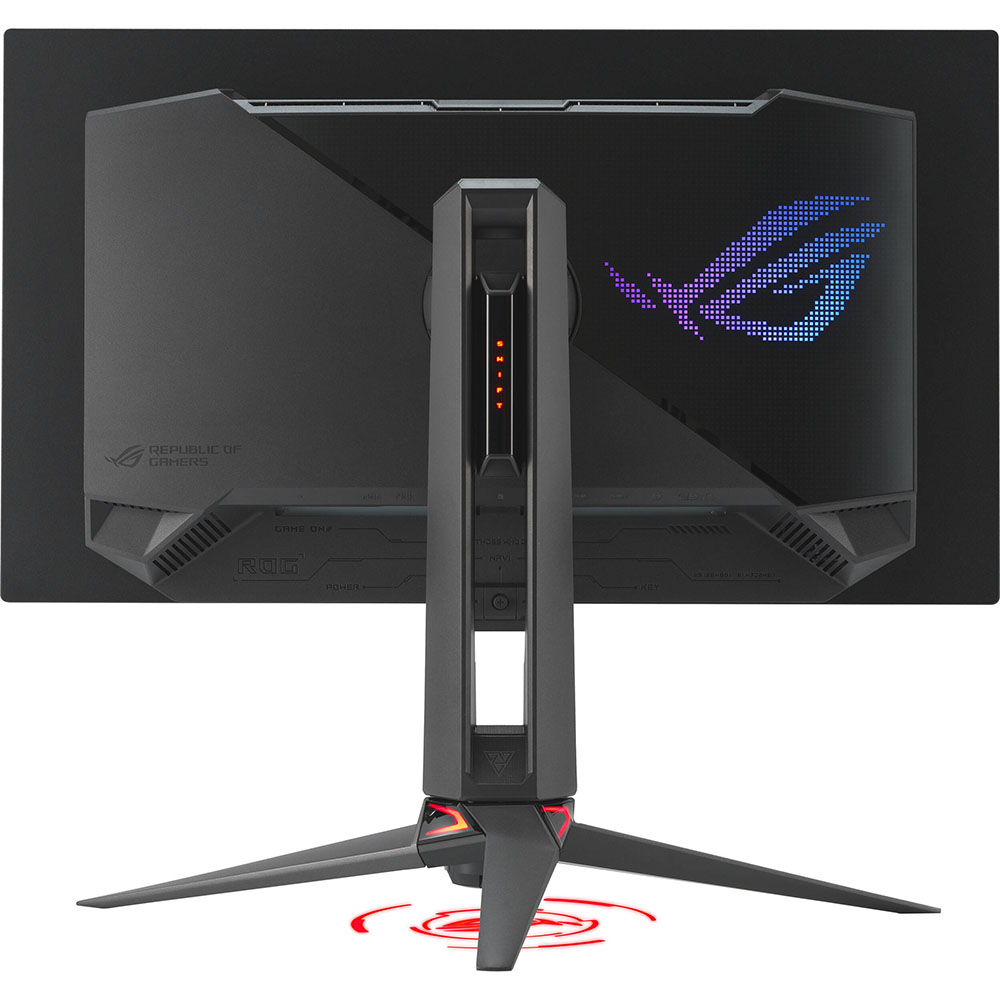
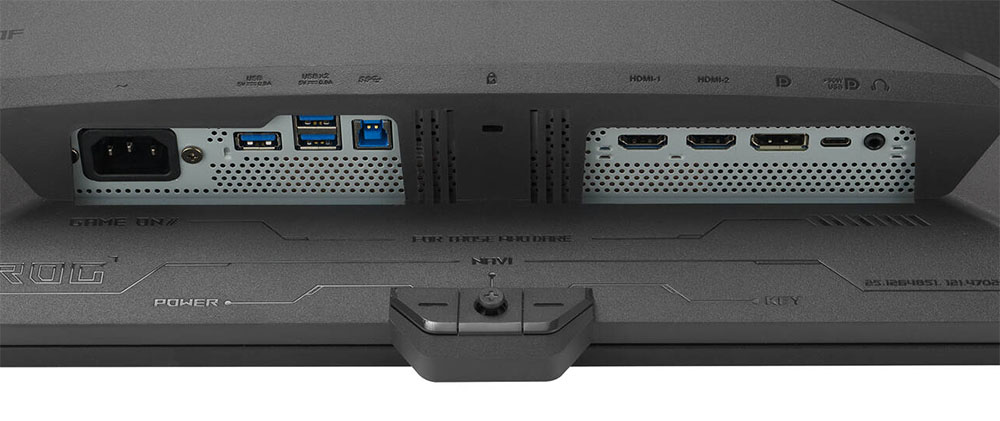
The PG27UCDM’s front view is minimalist with thin flush borders around the panel and no graphics except a backlit ROG logo on a small protrusion at the bottom center. It also contains a proximity sensor to dim the screen when no user is present as part of the OLED care option package. The front layer is shiny like most OLEDs, with an optical coating to cut glare. It’s reasonably effective, but some thought should be given to optimal placement by avoiding sunny windows and bright light sources.
The stand features classic ROG styling with a cast metal base and a stout upright with a cable hole in the middle. A logo projector shines onto the desktop at the bottom. It’s part of the lighting system and can show in multiple colors and effects. More lighting adorns the base and back, where you’ll find a large, pixelated ROG logo that reminds me a bit of the Lite Brite toy from the 60s and 70s where you’d stick colored pegs into a light box to make pictures. Ah, the nostalgia! Ergonomics include 5/20 degrees tilt, 30 degrees swivel, 4.4 inches of height range, and a 90-degree portrait mode. Movements are smooth and solid as I’d expect from a high-end display.
Underneath you’ll find a well-stocked input panel with a DisplayPort 2.1 (80Gbps), two HDMI 2.1 (48Gbps), a USB-C (DP functions with 90 watts of power), a 3.5mm headphone jack and USB 3.2 ports, one upstream and three down. You can also see the OSD joystick and two control keys, which toggle power and exit the menu.
OSD Features
The PG27UCDM’s OSD is extensive and includes everything imaginable to control gaming, image parameters, KVM and more. You can also download Asus’ DisplayWidget Center app, which mimics the OSD and adds firmware updates and app sync.
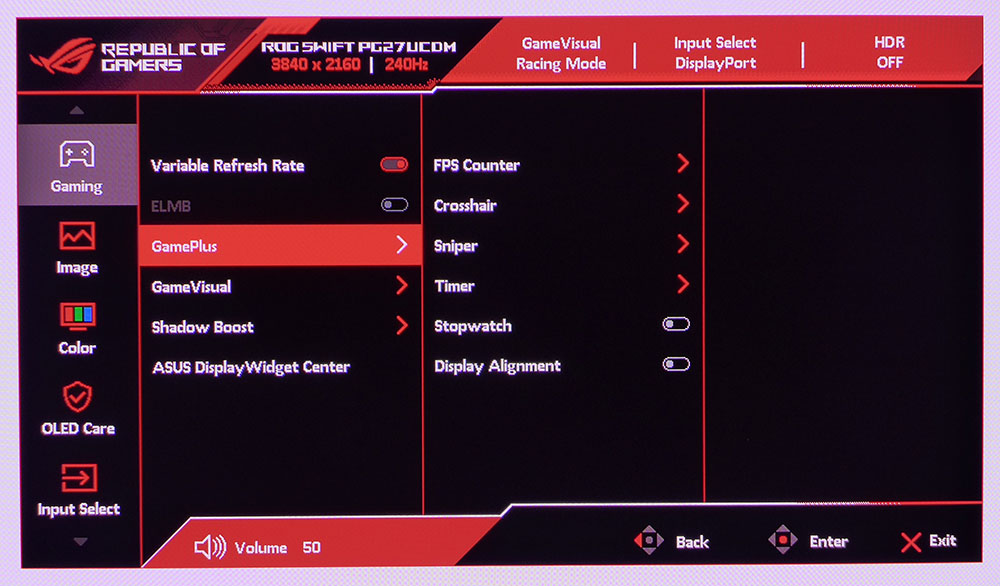
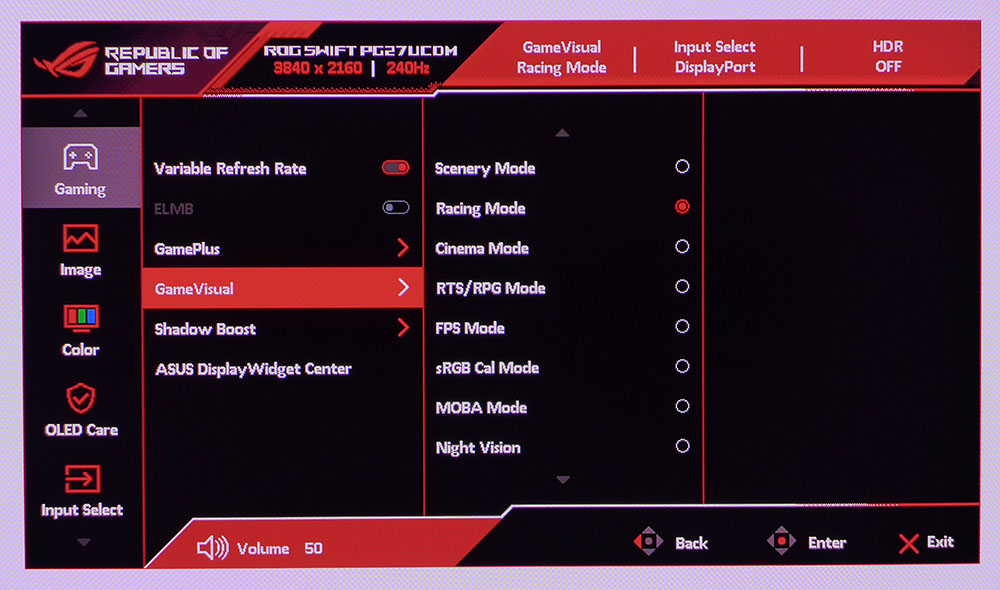
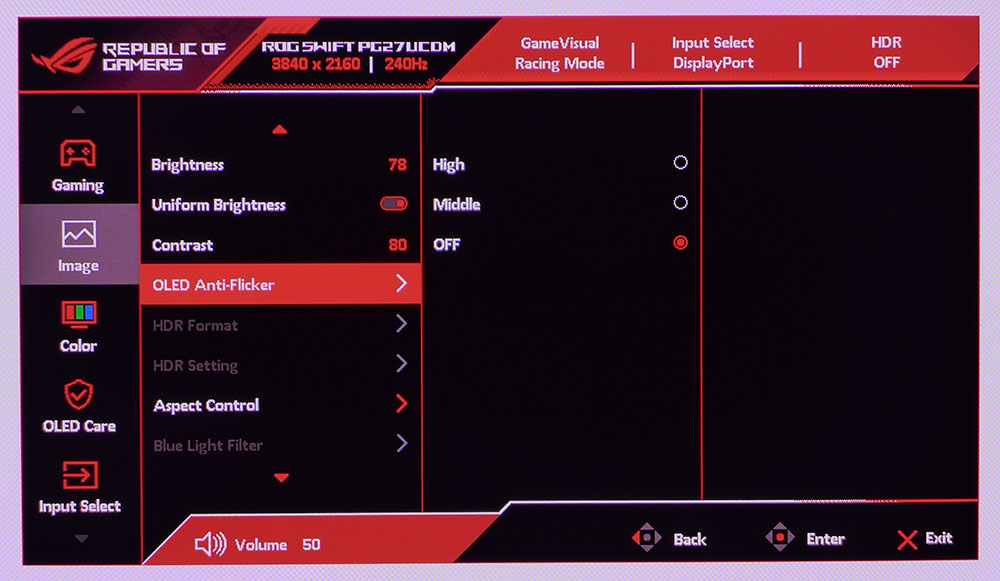
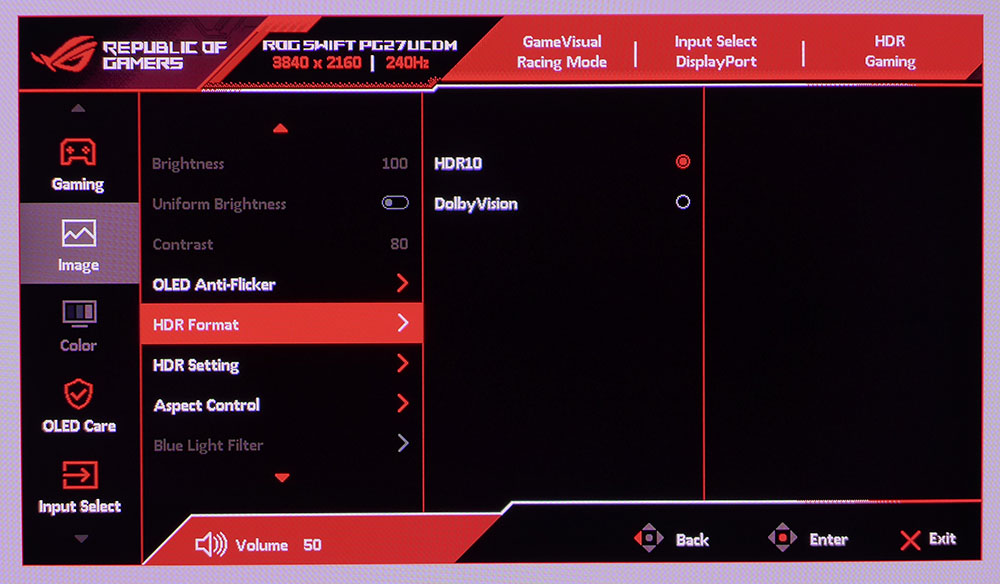
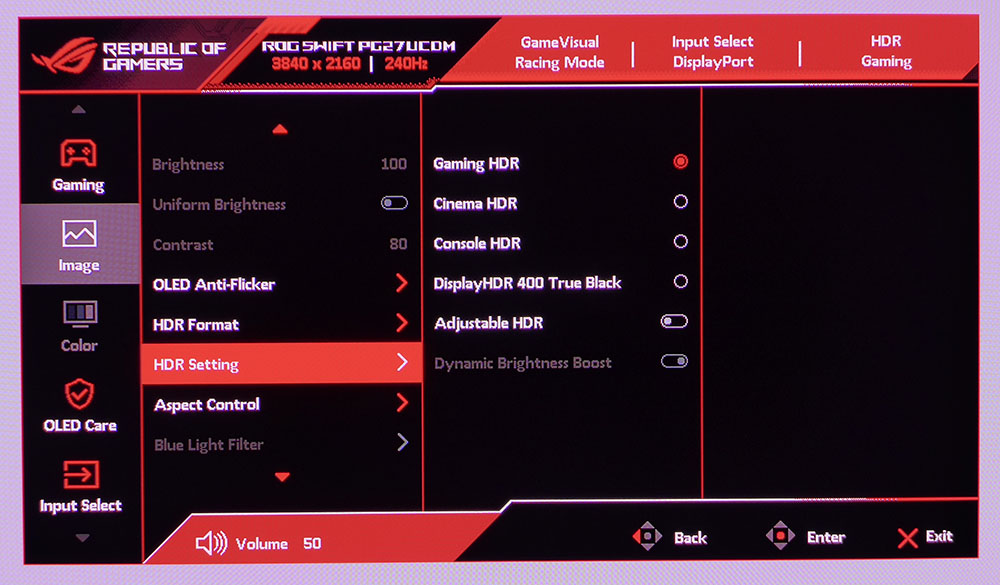
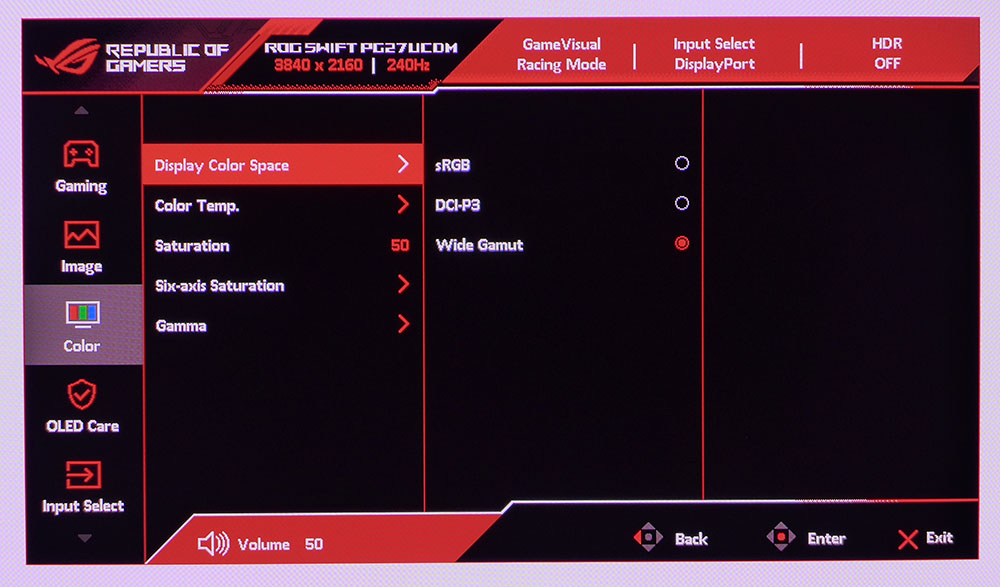
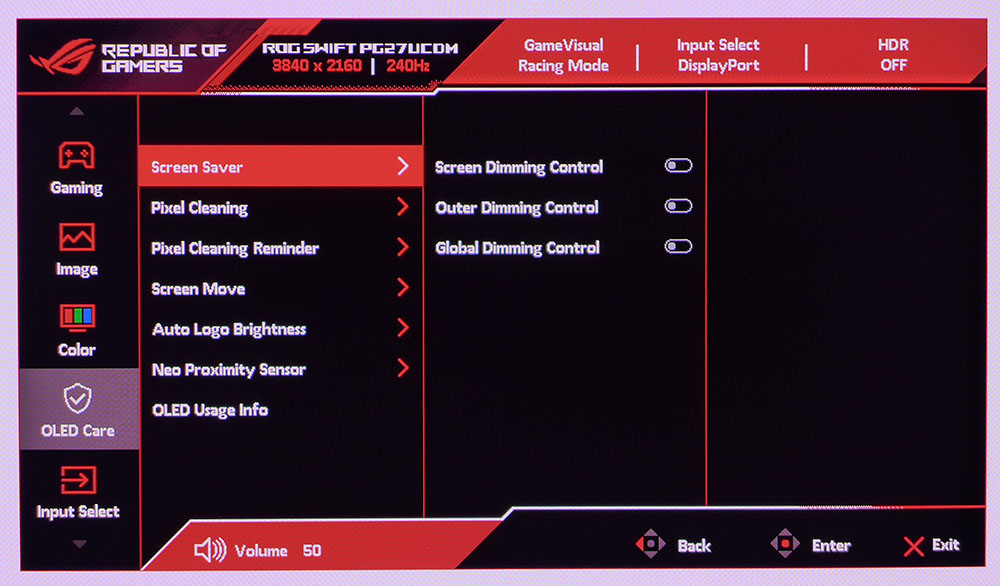
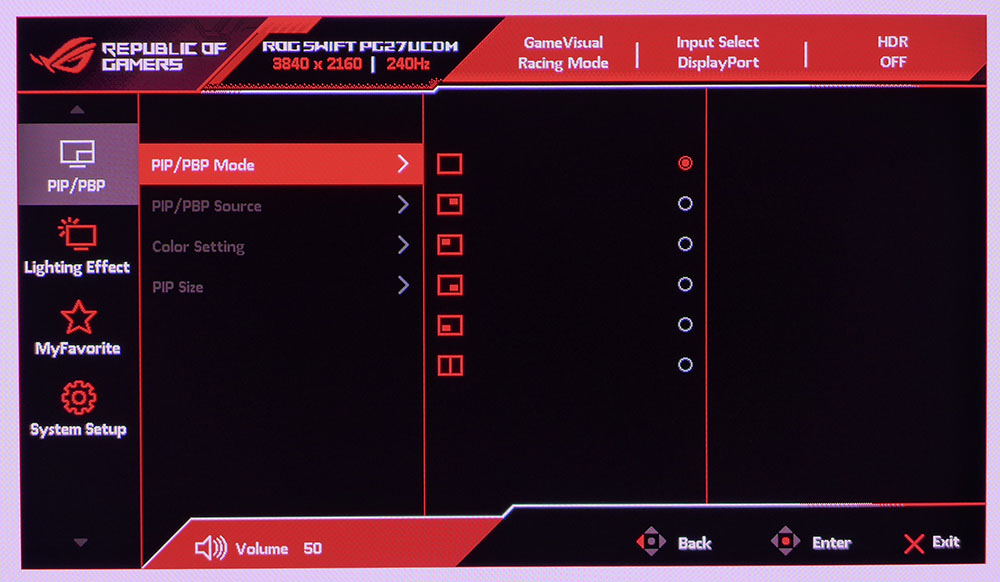
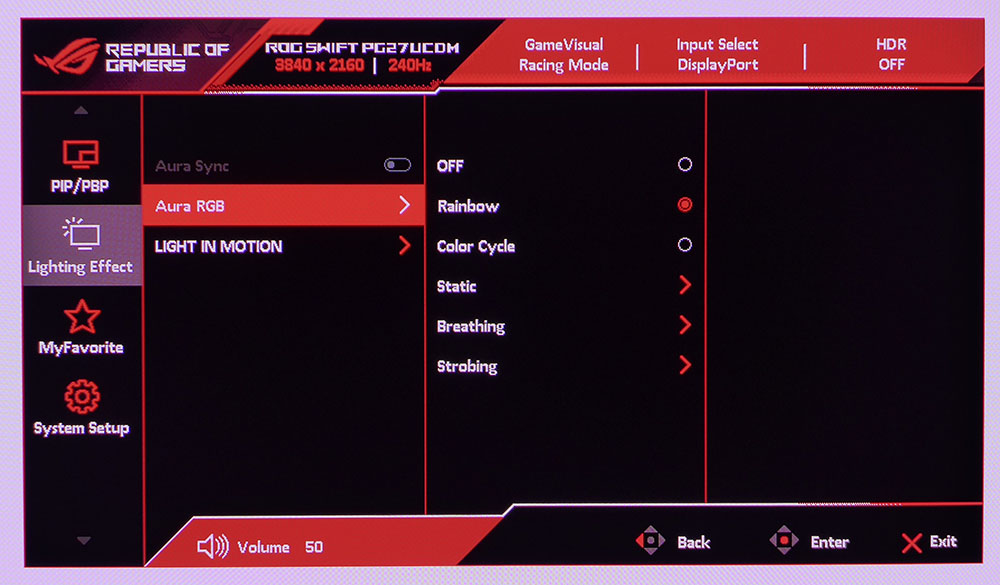
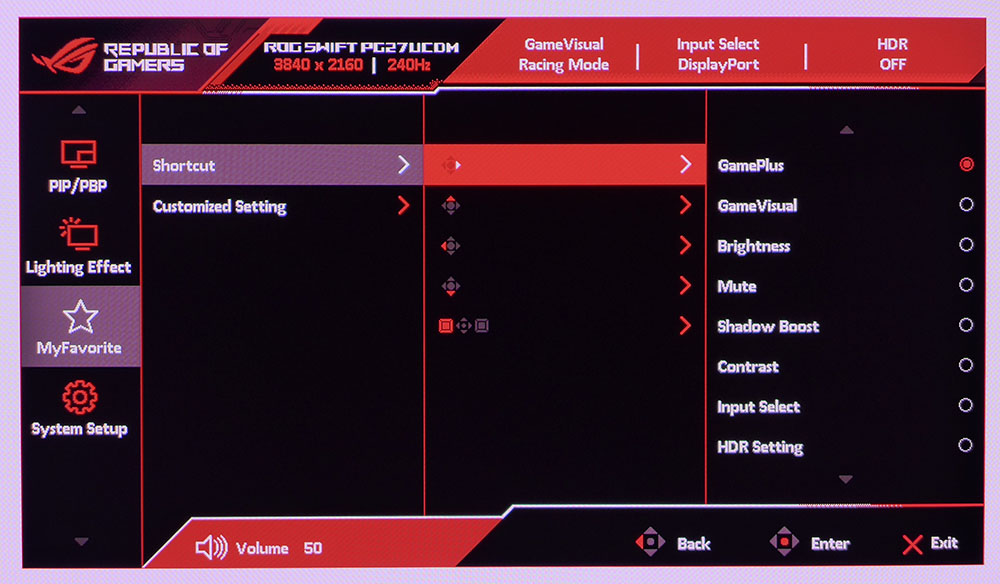
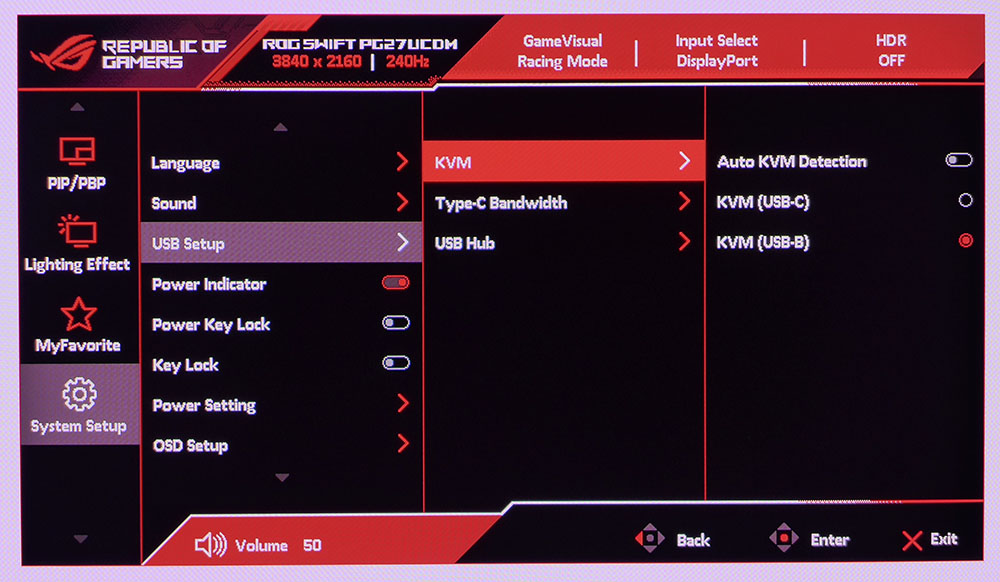
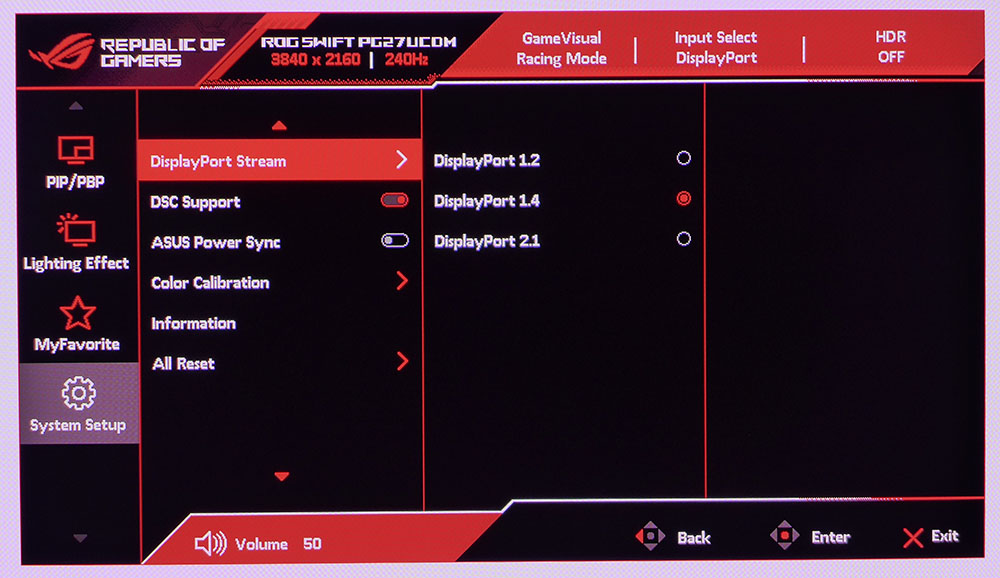
GamePlus delivers a full set of gaming aids with multiple aiming points, sniper mode, timers, stopwatch, FPS counter and display alignment marks. GameVisual is Asus’ term for picture modes, and you get nine of them aimed at specific tasks or game types. The default is Racing, and it is spot-on accurate for color and grayscale with a slightly light gamma. It can be calibrated to an even higher standard with fixed color temps, RGB sliders, gamma presets and gamut options.
The only video processing options are an Adaptive-Sync toggle and ELMB. Extra Low Motion Blur is the same as backlight strobing for an LCD, but in OLED form, it’s black frame insertion. At speeds above 150fps, it’s unnecessary because, like all fast OLEDs, there is no motion blur to remove. It’s useful at lower frame rates though and that’s a good thing because it’s limited to a maximum of 120 Hz.
The PG27UCDM includes both uniform and variable brightness options for both SDR and HDR. Using the latter punches up contrast noticeably, but can be harsh for workday tasks. The uniform setting keeps the light level constant regardless of content. A super cool touch is that the brightness slider setting stays where you set it when switching Constant Brightness on and off. That way, you can balance output without readjusting every time. This is something all OLEDs should have. Asus is the only company I know of that includes Anti-Flicker. It’s a subtle enhancement that appears during rapid changes in frame rate by keeping brightness consistent.
HDR10 and Dolby Vision are fully supported here, and the latter is a rare thing indeed. There aren’t many games that use it, but it is common in video, especially from Netflix. This makes the PG27UCDM great for content creators. HDR content enables four new picture modes with a toggle for brightness and contrast adjustment. You can also tweak grayscale if you like.
OLED care options are extensive and include screensavers, pixel cleaning, orbiter, logo and edge dimming and a proximity sensor. When activated, the screen dims if you aren’t sitting in front of the PG27UCDM. At the bottom, you can track panel hours and automatically run a refresh cycle every eight hours.
If you want to view two video sources at once, there are options for PBP and PIP with independent color settings. Lighting is controlled by Aura RGB and Light In Motion options where you can pick from different colors and effects, and sync the light show to what’s happening on the screen. The four joystick directionals can be programmed to a variety of quick access functions like picture modes and gaming aids. In the System menu is the KVM feature which gives you many options for configuring the USB hub and video/peripheral bindings. Finally, if you need backward compatibility for the DisplayPort, it can be set to version 1.4 or 1.2.
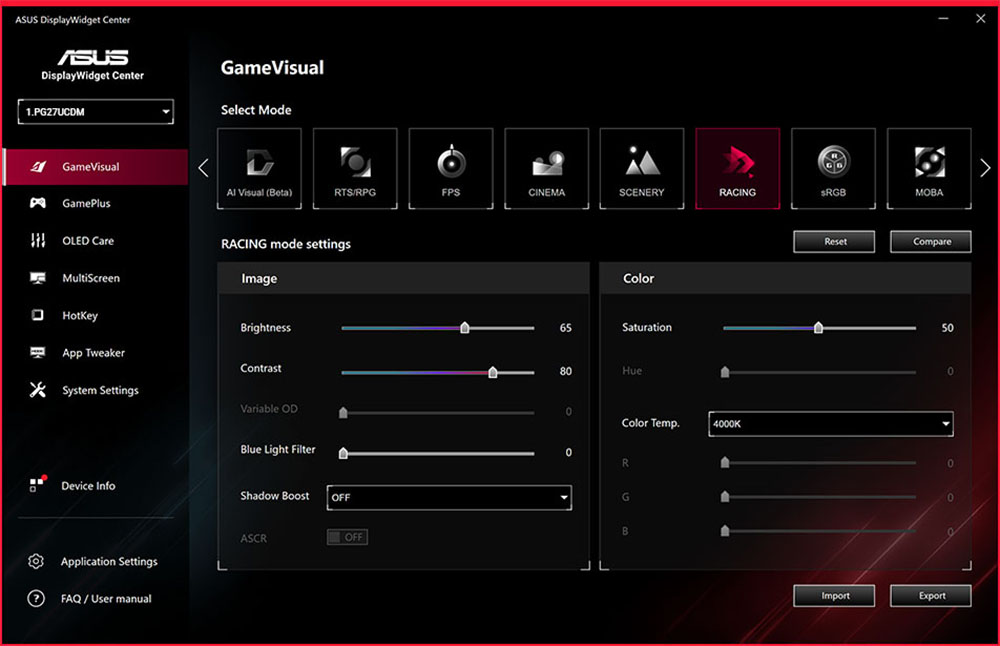
If you prefer to control the PG27UCDM from the Windows desktop, Asus offers DisplayWidget Center. It mimics all OSD functions and adds some extras like firmware updates and app sync. This lets you bind games or other applications to monitor settings for automatic mode switching when the appropriate program is run. This is something you won’t find anywhere else.
Asus ROG Swift PG27UCDM Calibration Settings
The PG27UCDM has many calibration options and picture modes but the only one you really need is Racing. It can be used sans calibration out of the box, but I noticed that gamma was a tad light. I selected the User color temp and adjusted a very precise set of RGB sliders. This not only reduced color errors, but it also tightened up gamma tracking to perfection. The choice between variable and constant brightness is made easier by the fact that brightness settings made in each mode are independent. That allows one to equalize picture brightness without readjusting the slider each time, very cool. My settings below reflect both configurations.
You only need to pick between Dolby Vision and HDR10 in HDR mode. For HDR10, there are four picture modes, of which Gaming is the default and best choice. A True Black mode is included, but it measured almost identically to Gaming. HDR color was spot-on from my sample, but you can tweak RGB and gamma if you like. You can also engage a toggle to allow brightness adjustments.
Picture Mode | Racing |
Constant Brightness | On / Off |
Brightness 200 nits | 78 /42 |
Brightness 120 nits | 45 /23 |
Brightness 100 nits | 37 / 18 |
Brightness 80 nits | 28 / 14 |
Brightness 50 nits | 17 / 12 (min. 7 / 24 nits) |
Contrast | 80 |
Gamma | 2.2 |
Color Temp User | Red 96, Green 98, Blue 100 |
Gaming and Hands-on
While it’s easy to be seduced by large and colorful monitors, I’m talking about 32 inches or more, there is something about high pixel density that is equally enticing. In the mainstream, there isn’t anything with more density than a 27-inch 4K panel and its sharpness and clarity is something you can see in a side-by-side comparison.
Though Doom Eternal is a frenetic fragfest, there is a lot of fine detail and texture in its virtual world that should be paused and enjoyed when playing on a monitor like the PG27UCDM. Compared to other OLEDs, it’s equally colorful and boasts equal contrast. But the 163ppi is something you won’t see on a 32-inch screen. I stopped many times, when I wasn’t being attacked, to appreciate what the game’s creators had done, especially on surfaces. Reflective metal looked particularly realistic with different levels of shine that depended on color and texture. Little chips and scratches were rendered clearly and the word “tactile” came to mind on many occasions. This is a case where size does not matter. Spend five minutes playing your favorite game on the PG27UCDM and you won’t wish for a larger screen.
Video processing is OLED-excellent with perfect motion resolution at all frame rates above 150fps. My test system kept the action above 220 and I never saw the slightest hesitation or blur. There are a few QHD monitors out there with less input lag but the PG27UCDM never failed to deliver on my wishes. I can’t imagine anyone not thinking it’s fast.
To test its Dolby Vision capability, I hooked up an Apple TV 4K. To enable the codec, I had to select the format in the OSD, then test it from the source. It worked without any issues when playing Netflix shows like Formula 1 Drive To Survive and Car Masters Rust To Riches. I also noted that it correctly matched frame rates with content mastered in 24p and 50p. The PG27UCDM is a great personal TV although since there are no internal speakers, you’ll need a good pair of headphones to enjoy the show.
I had installed Asus’ DisplayWidget Center during a previous review and noted that when I ran it, the PG27UCDM was instantly detected along with the settings I had already made in the OSD. It’s a super convenient way to make adjustments and I appreciated the added function of app binding where you can change picture modes automatically when running specific games or programs, very cool.
For productivity, there is nothing better than 4K when viewing fine photo detail or writing prose using ornate fonts. Pixel density is a clear asset for workday tasks and though my vision isn’t fighter pilot worthy, I had no trouble making everything out. That’s another instance where I didn’t notice the 27-inch size even though I’m accustomed to a 32-inch screen.
Takeaway: During my time with the PG27UCDM, I could find nothing to complain about. It serves incredibly well for gaming, entertainment and work and makes those activities a pleasure. Gameplay has the addictive quality I’ve come to expect from any fast OLED and that high pixel density is something you won’t regret paying extra for.
MORE: Best Gaming Monitors
MORE: How We Test PC Monitors
MORE: How to Buy a PC Monitor
Current page: Features and Specifications
Next Page Response, Input Lag, Viewing Angles and Uniformity
Christian Eberle is a Contributing Editor for Tom's Hardware US. He's a veteran reviewer of A/V equipment, specializing in monitors. Christian began his obsession with tech when he built his first PC in 1991, a 286 running DOS 3.0 at a blazing 12MHz. In 2006, he undertook training from the Imaging Science Foundation in video calibration and testing and thus started a passion for precise imaging that persists to this day. He is also a professional musician with a degree from the New England Conservatory as a classical bassoonist which he used to good effect as a performer with the West Point Army Band from 1987 to 2013. He enjoys watching movies and listening to high-end audio in his custom-built home theater and can be seen riding trails near his home on a race-ready ICE VTX recumbent trike. Christian enjoys the endless summer in Florida where he lives with his wife and Chihuahua and plays with orchestras around the state.
-
cknobman For gaming this is just a waste of money IMO.Reply
4k at this size does not offer much benefit unless you are a foot or less from the screen. -
Energy96 Reply
I disagree, unless you have cataracts the difference is very noticeable. I have a 27” 1440p and a 32” 4k as well on other machines. The difference is very noticeable even at the usual 2-3 ft from the screen, side by side is even more noticeable.cknobman said:For gaming this is just a waste of money IMO.
4k at this size does not offer much benefit unless you are a foot or less from the screen.
I had a high end 27” 4k IPS ASUS ROG Swift PG27UQ before I picked this monitor up last month and it’s really good. This one is even better and so much more colorful, the blacks are unbelievable. Side by side (currently the old IPS is used as second screen) the difference is ridiculous and that was a $1500+ IPS ROG monitor. Comparatively $1200 was a bargain.
The only minor annoyance is pixel refresher reminder pops up pretty frequently and is annoying when in the middle of playing something. I probably should just disable the reminder. Also the proximity sensor is not sensitive enough. I have often had it go black while I am sitting there playing a game but must have been very still. It does come back instantly if I move though. It would be better if it cross referenced lack of motion with any screen or mouse movement. It should only go black if the screen is also still. Minor things and all can be adjusted or disabled I suppose.
I don’t think a better screen exists in 27” size. -
PrazVT I don't have space for a 32" but I game at 4k, so I did pick this one up. I came from the LG 27" mini led, which was a nice monitor, but still had black crush / blooming issues despite the large # of dimming zones. I love the PG27UCDM so far. Between the feature set and image quality / performance it's just been a joy to use. The only real bug right now is with the proximity sensor. Despite a recent firmware update, the monitor will go dark after the timer even if you're in front of it and you have to wave your hand to get the monitor to come back on. So I have it disabled until they fix that. Otherwise, between the OLED Care features and just me being more mindful of the static content (b/c I use this monitor for productivity during the day) I am generally happy with the burn-in prevention features.Reply
Yes, the monitor is expensive for the size (ie...costs the same as my Sony OLED TV) ..but it is damn nice. -
RTX 2080 Reply
I’ve owned several monitors, including a 27 inch 4K monitor. It does offer a benefit.cknobman said:For gaming this is just a waste of money IMO.
4k at this size does not offer much benefit unless you are a foot or less from the screen. -
lmcnabney HDR10 is not exactly high end. That is where HDR starts. I would have expected HDR600 if not HDR1000 for this price. It is odd that OLED can't do it.Reply -
endocine Reply
Are you guys doing screen scaling or are you 100% default?Energy96 said:I don’t think a better screen exists in 27” size. -
UnforcedERROR Reply
These mean different things. HDR10 is a video standard. HDR600/1000 are specs relating to overall brightness. Having HDR10 is useful for media consumption as it's a fallback from Dolby Vision. HDR10 and Dolby Vision are also starting to be looked at as viable HDR solutions for gaming (which if you've gamed in HDR you know it's a crap shoot for quality).lmcnabney said:HDR10 is not exactly high end. That is where HDR starts. I would have expected HDR600 if not HDR1000 for this price. It is odd that OLED can't do it. -
Energy96 Reply
You are mixing up 2 different things.lmcnabney said:HDR10 is not exactly high end. That is where HDR starts. I would have expected HDR600 if not HDR1000 for this price. It is odd that OLED can't do it.
This OLED is about as bright as they get. -
Energy96 Reply
Are you talking about the windows setting or a game setting?endocine said:Are you guys doing screen scaling or are you 100% default?
Windows is at the usual recommended 150% when connecting a 4k monitor. 100% the text would be extremely small.
In games I always run native 4k scaling. -
lmcnabney Reply
OLED is intrinsically high in contrast. Brightness is not contrast. These panels may just be relatively low NITS.Energy96 said:You are mixing up 2 different things.
This OLED is about as bright as they get.
(pulls technical data on the display)
Yep, this display only does 250 nits across the panel and can get as high as 1000 nits, but only 3% of the display can be lit to attain that number. I suspect this low brightness is related to refresh or is required to lower the deterioration rate.
